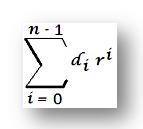Subscribe to our ▶️ YouTube channel 🔴 for the latest videos, updates, and tips.
Number System
In number system modern method of representing numbers symbolically is based on positional notations.
In this method, each number is represented by a string of symbols where each symbol is associated with a specific weight depending upon its positions. The total number of different symbols which are used in a particular number system is called the base or radix of the system and the weight of each position of a particular number is expressed as a power of the base. When a number is formed with the combination of the symbols, each symbol is then called a digit and the position of each symbol is referred to as the digit position.
Thus if a number system has symbols starting from 0, and the digits of the system are 0, 1, 2, ….. (r - 1) then the base or radix is r. If a number D of this system be represented by
D = d₀ d₀ ……. d₀…….. d₁ d
then the magnitude of this number is given by

Where each d₀ ranges from 0 to r - 1, such that
0 ≤ d₀ ≤ r - 1, i = 0, 1, 2 ...... (n - 1).
The digit at the extreme left has the highest positional value and is generally called the Most Significant Digit, or in short MSD; similarly, the digit occupying the extreme right position has the least positional value and is referred to as the Least Significant Digit or LSD.
- Decimal Number System
- Why Binary Numbers are Used
- Binary to Decimal Conversion
- Conversion of Numbers
- Hexa-decimal Number System
- Conversion of Binary Numbers to Octal or Hexa-decimal Numbers
- Octal and Hexa-Decimal Numbers
- Signed-magnitude Representation
- Radix Complement
- Diminished Radix Complement
- Arithmetic Operations of Binary Numbers
From Number System to HOME PAGE
Didn't find what you were looking for? Or want to know more information about Math Only Math. Use this Google Search to find what you need.


New! Comments
Have your say about what you just read! Leave me a comment in the box below. Ask a Question or Answer a Question.